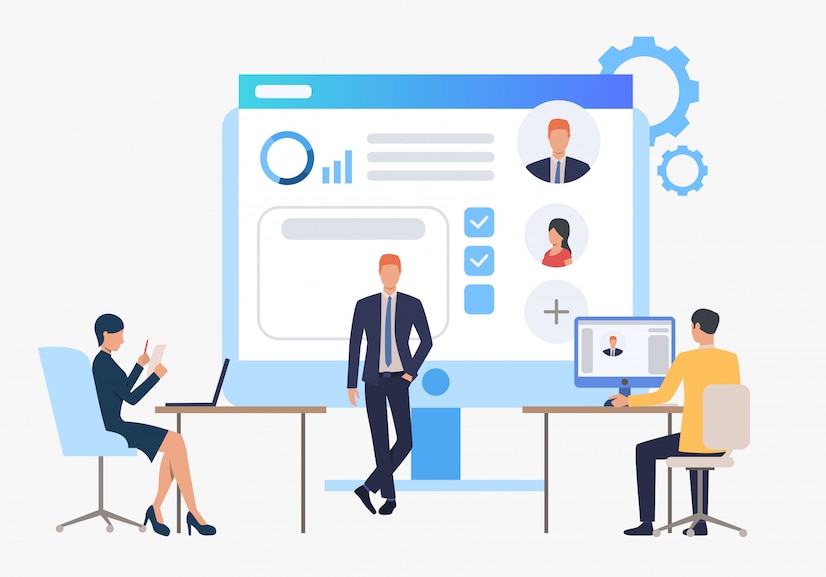
Top Features of HR Management Software
Every company should make managing employees a top priority. However, HR managers often get so caught up in the daily grind that they don’t have time to nurture talent. It is why HRM software could be a game-changer.
To determine your functional requirements for an HRMS system, you can refer to the list of HRMS features below.
Software for managing human resources is essential
- People management
Once your company grows, keeping all data in spreadsheets becomes challenging. It can be tedious to go through every document to ensure they match.
A human resource management system is, at its core, a database that contains all employee records. This information could include employees’ names, positions, and dates of hire, job duties, benefits, insurance plans, and performance history.
This information can be linked to an employee’s profile, so you can quickly find the records if needed.
- Talent management and performance
An HBR survey found that promoting the right person can be one of the most effective ways to make your business successful.
The most important aspect of the promotion process is the inclusion of human resource software. It adds transparency and objectivity to the process. Define KPIs and track productivity.
Management 360-degree reviews can be time-consuming, as any HR manager knows. HRM software streamlines this process by allowing for regular 60-, 90- and 90-day studies.
Automated feedback forms will enable you to collect data from many sources and display the results on a central dashboard.
- Staff benefits
Companies must manage employee benefits, including pension contributions, healthcare plans, and salary. It is often the most time-consuming activity in HR software. Automation in HRM can make it easier for employees to manage their wages and benefits.
All-in-one software allows you to create employee plans, define eligibility criteria, manage compensations, pay vacations, calculate taxes and 401k contributions and fill out social security reports.
Regular employees should be able to enroll in benefits using HRM software. It will reduce administrative work and errors.
- Accounting and finance
Every year, 82 million Americans have to deal with payroll problems. An HRM system can streamline your accounting and reduce human error.
You might be interested in the following features: Wages administration, tax management, bonus management, stock options, and long-term incentive management.
Accounting automation is another proper function in the HR system. It can calculate wages, deduct taxes and run what-if scenarios.
- Hiring and on boarding
It is as important to track applicants as it is to manage your workforce. Modern Application Tracking Systems can post job vacancies on job boards and social media. It will also help you collect hundreds of resumes and rank them according to pre-set criteria.
Most human resource management systems have basic ATS functionality. These systems are usually little more than a searchable database that you can use for your applicants and vacancies. Many allow you to post vacancies on different sites and to view your calendar to schedule interviews.
- Education and Development
The OECD predicts that technology will transform nearly 1 billion jobs within the next decade. It’s not surprising that market leaders like Amazon and PwC spend billions on keeping their employees current.
A corporate Learning Management System (or corporate Learning Management System) is an effective tool to help you train your employees cost-effectively and structured way. You can often find essential learning management within HRIS software modules, just like an ATS.
- Time and attendance management
Tracking and calculating paid time off (PTO) can be challenging. It is why many HRM software packages include automated PTO management. The system will adjust the time-off calculation based on the workers’ leave.
You can schedule shifts across departments, geographies, and projects. Get automated notifications when the roster changes. Track PTO used/accrued. Clock in/out. Manage disability and maternity leave. All of these essential features make an excellent HRS.
- Talent retention
The cost of losing a worker could be anywhere from 30% to 400% of an employee’s annual salary. Many HRM systems can help you devise and implement simple strategies to retain your employees.
The HRM software allows you to analyse clusters of employees with similar patterns and help you create targeted retention policies.
Data is just one tool in the arsenal of an HR manager. According to Deloitte, accurate and complete data is still a significant challenge in HR analytics. Data aggregation and preparation can be a challenge for any enterprise with 5-7 systems of records.
- Analytics, reporting, and document management
If you can’t use it, data is useless. Big Data transformed marketing and finances, and you can also benefit from information about your employees’ past and current.
A variety of reports should include in your HRM software, including those dealing with absenteeism, employee performance, staffing requirements, growth by department, and staffing needs.
It is equally essential to be able to customize reports and visualize data for more straightforward analysis. You can also export insights in a variety of formats.
A good HRM will have an easy way to manage documents, especially for industry-specific documents like certificates, licenses, and compliance.
- Security, compliance, and other considerations
Although HRMS features are important, they are not the only thing essential. Gartner reports that global entrepreneurs are becoming more aware of cybersecurity threats.
Attacks on sensitive financial or personal information can target HR departments. Your HRMS must adhere to cybersecurity best practices.
Another essential aspect to think about is user experience. As crucial as fancy features are ease of navigation, intuitive design, and a fast interface, so is user experience. Make sure the system works on all mobile devices and is simple for everyone, even non-technical users.
It is not your intention to be alone when things go wrong. Make sure you have the support you need when running your HRMS.
Conclusion
All companies need to manage their human resources. The key features of human resources management software aim to free you from routine tasks and allow you to concentrate on recruiting, motivating, and retaining top talent.
Unfortunately, there is no single solution for HRM software. You will need to evaluate your HR requirements to find the right system.
Identify the essential features for your company. For some, there may be an already existing solution. Others may find it challenging to use out-of-the-box software.
It might be worth creating a custom-made HRIS system tailored to your company’s culture and processes.






